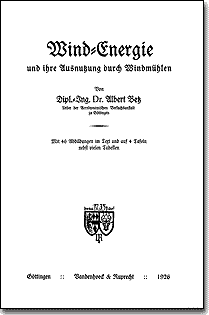
Betz'
Law

![]() The
Ideal Braking of the Wind
The
Ideal Braking of the Wind
The more kinetic energy a wind turbine pulls out of
the wind, the more the wind will be slowed down as it leaves
the left side of the turbine in the picture. (If you wonder about
the stream tube in the picture, you have not read the page on
how the wind turbine deflects the wind).
![]() If we tried to extract all the energy from
the wind, the air would move away with the speed zero, i.e. the
air could not leave the turbine. In that case we would not extract
any energy at all, since all of the air would obviously also
be prevented from entering the rotor of the turbine.
If we tried to extract all the energy from
the wind, the air would move away with the speed zero, i.e. the
air could not leave the turbine. In that case we would not extract
any energy at all, since all of the air would obviously also
be prevented from entering the rotor of the turbine.
![]() In the other extreme case, the wind could
pass though our tube above without being hindered at all. In
this case we would likewise not have extracted any energy from
the wind.
In the other extreme case, the wind could
pass though our tube above without being hindered at all. In
this case we would likewise not have extracted any energy from
the wind.
![]() We can therefore assume that there must be
some way of braking the wind which is in between these two extremes,
and is more efficient in converting the energy in the wind to
useful mechanical energy. It turns out that there is a surprisingly
simple answer to this: An ideal wind turbine would slow down
the wind by 2/3 of its original speed. To understand why,
we have to use the fundamental physical law for the aerodynamics
of wind turbines:
We can therefore assume that there must be
some way of braking the wind which is in between these two extremes,
and is more efficient in converting the energy in the wind to
useful mechanical energy. It turns out that there is a surprisingly
simple answer to this: An ideal wind turbine would slow down
the wind by 2/3 of its original speed. To understand why,
we have to use the fundamental physical law for the aerodynamics
of wind turbines:
Betz'
Law

![]() Betz' law says that you
can only convert less than 16/27 (or 59%) of the kinetic energy
in the wind to mechanical energy using a wind turbine.
Betz' law says that you
can only convert less than 16/27 (or 59%) of the kinetic energy
in the wind to mechanical energy using a wind turbine.
![]() Betz' law was first formulated by the German
Physicist Albert Betz in 1919. His book "Wind-Energie"
published in 1926 gives a good account of the knowledge of wind
energy and wind turbines at that moment.
Betz' law was first formulated by the German
Physicist Albert Betz in 1919. His book "Wind-Energie"
published in 1926 gives a good account of the knowledge of wind
energy and wind turbines at that moment.
![]() It is quite surprising that one can make
such a sweeping, general statement which applies to any wind
turbine with a disc-like rotor.
It is quite surprising that one can make
such a sweeping, general statement which applies to any wind
turbine with a disc-like rotor.
![]() To prove the theorem requires a bit of math
and physics, but don't be put off by that, as Betz himself writes
in his book. Betz' own proof
of the theorem is included in the Reference
Manual on this web site.
To prove the theorem requires a bit of math
and physics, but don't be put off by that, as Betz himself writes
in his book. Betz' own proof
of the theorem is included in the Reference
Manual on this web site.
© Copyright 1999 Soren Krohn. All rights reserved.
Updated 6 August 2000
http://www.windpower.org/tour/wres/betz.htm